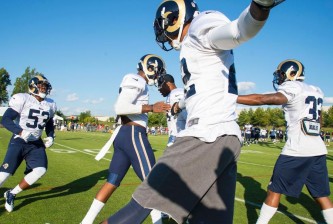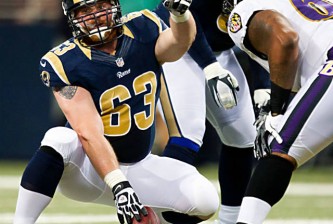
Talks between NFL players and owners break down. Whose game is it anyway?
Posted by Will Horton on Feb 10, 2011 16:16
Ryan Burns, in his latest Football Sickness podcast, said of the labor talks: “I’m like Milton Bradley and dinosaurs when it comes to the Lockout. I refuse to believe it exists.”
This carefully architected attitude of disbelief allows us to imagine the Rams taking big steps forward — Bradford soaking in the McDaniels offense as offensive pieces big and small get plugged in via draft and free agency, roster competition is added, minicamps and team-structured rehab sessions reinvest in assets like Donnie Avery and Mardy Gilyard. It allows us to go on talking football as if everything was normal.
But it’s not. Talks between the owners and the NFLPA have broken down. And come March 4th, without an agreement, the NFL shuts down.
 SI_JimTrotter
SI_JimTrotterGoodell canceles the next CBA meeting? Two owners to me: If nothing before March 4, nothing till Labor Day at earliest.
Doug Farrar of the Shutdown Corner tells us what happens next:
Players will not be able to report to team facilities for any reason – workouts, injury rehab, meetings. Team staffs may see their salaries cut, and some may lose their positions for the length of the lockout, or even longer.
The players’ health insurance will lapse, and it’s entirely likely that players injured on the field will have to arrange for their own medical care. Free agency will not exist until there is a new agreement, and a lot of NFL players will essentially be unemployed.
It’s tough for fans like us to stomach. And if it takes two to tango, it doesn’t help that one dance partner is looking to brawl. And as Jason Cole writes, that certainly seems to be the case:
“There are some owners out there who didn’t like how the last round went,” one league executive said. “You’re talking about some smart business people who felt like they were beaten at what they do best … there are some hard feelings about that.”
One of the prime examples has been Carolina Panthers owner Jerry Richardson, who has been leading the call for owners to “take back our game,” as he said during a firebrand speech at the league’s three-day meeting in March 2010.
This attitude begs the question: Whose game is it?
Does it belong to the players who aren’t allowed to show their own faces on the field? Does it belong to the owners who never played it? Does it belong to Commissioner Roger Goodell, called “the most powerful man in sports” by Sports Illustrated and BusinessWeek alike? Does it belong to the networks who pay billions of dollars annually for the right to broadcast it, or to the advertisers who pump this financial firehose? Does it belong to the kid with the Sam Bradford fathead on his wall who will likely never get within fifty feet of his idol?
Or am I mistaken in even assuming that “the game” that Jerry Richardson is talking about is football?
The way these “talks” are playing out has much more to do with “The Game” as described by The Wire — the constant hustle for dollars, for power, for respect. That game never changes, and as Omar famously says, “It’s play or get played. That simple.”
For the fans, then, if this is the game being played then all there is to do is try and stay out of the crossfire.






















